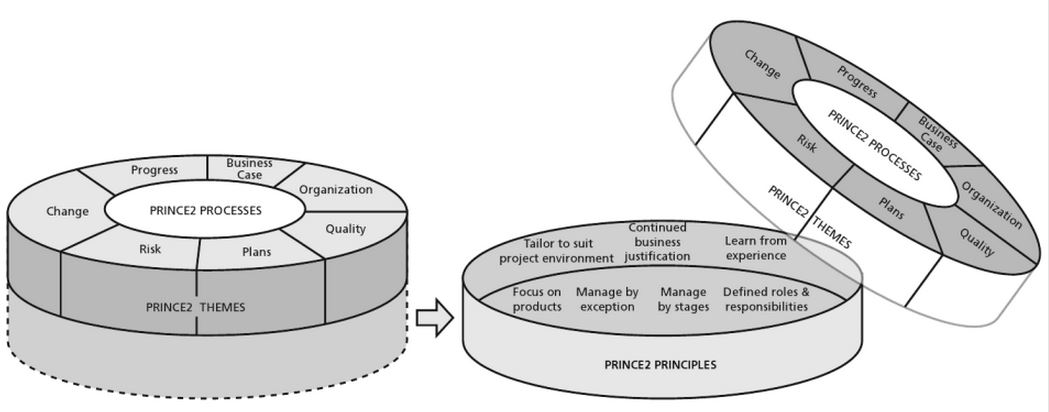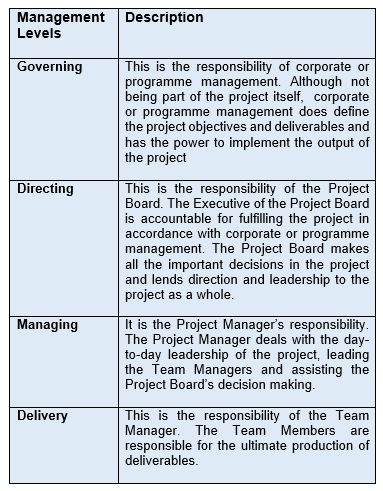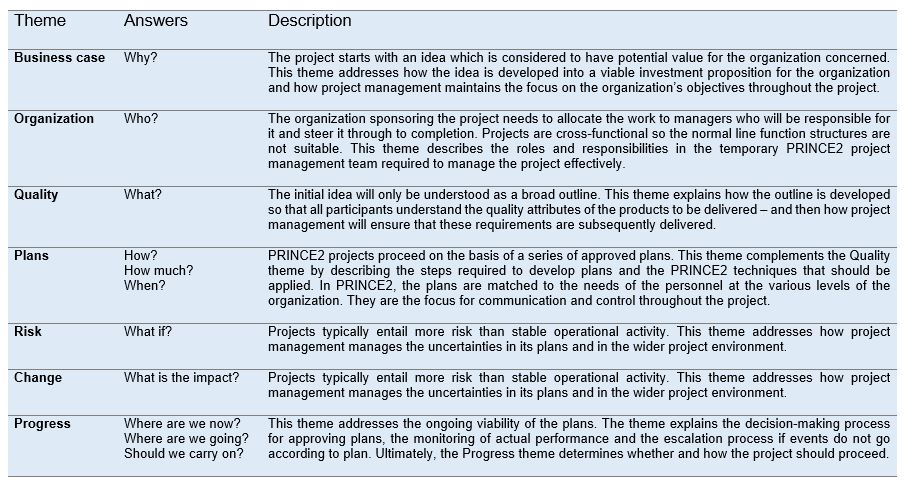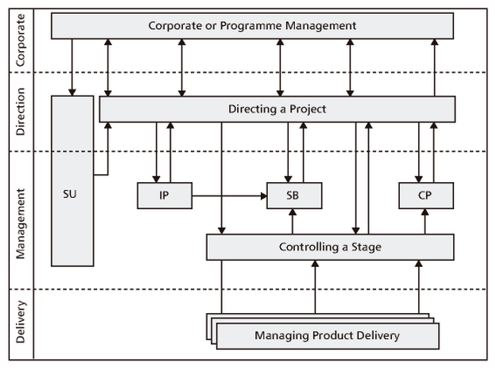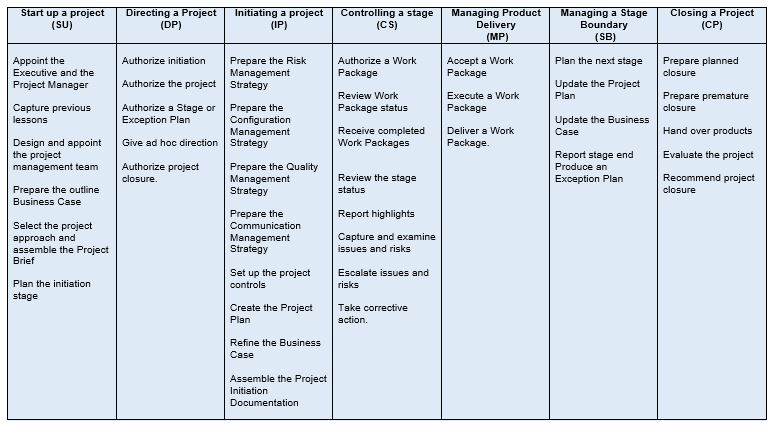PRINCE2
(→The method) |
(→The method) |
||
| Line 5: | Line 5: | ||
Every project has six variables and therefore six performance aspect that need to be managed: costs, time, quality, scope, risk and benefits. Prince2 is an integrated framework of processes and themes that address the planning, delegation, monitoring and control of all these six aspects of project performance. At its core, the method has seven principles, which are guiding obligations and practices that determine whether the project is managed using a PRINCE2 approach. In order to provide guidance on how the process should be performed, there are seven themes – aspects of the project management that need to be addressed continually through the project lifecycle. Being a process model of approaching project management, PRINCE2 has a series of activities that are required to direct, manage and deliver a project. | Every project has six variables and therefore six performance aspect that need to be managed: costs, time, quality, scope, risk and benefits. Prince2 is an integrated framework of processes and themes that address the planning, delegation, monitoring and control of all these six aspects of project performance. At its core, the method has seven principles, which are guiding obligations and practices that determine whether the project is managed using a PRINCE2 approach. In order to provide guidance on how the process should be performed, there are seven themes – aspects of the project management that need to be addressed continually through the project lifecycle. Being a process model of approaching project management, PRINCE2 has a series of activities that are required to direct, manage and deliver a project. | ||
| − | <ref name=''Managing successful projects with PRINCE2 (5th ed.). (2009). London: TSO'' /> | + | <ref name=''Managing successful projects with PRINCE2 (5th ed.). (2009). London: TSO'' > </ref> |
<ref name=''3''> ''Hedeman, B., & Heemst, G. (2010). Project Management Based on PRINCE2 2009 Edition. Zaltbommel: Van Haren Pub.'' </ref> | <ref name=''3''> ''Hedeman, B., & Heemst, G. (2010). Project Management Based on PRINCE2 2009 Edition. Zaltbommel: Van Haren Pub.'' </ref> | ||
Revision as of 10:12, 21 September 2015
PRINCE2 (an acronym for PRojects IN Controlled Environments) is a process-based method for effective project management. It is one of the most accepted and used methods in project management due to the fact that it can be applied to any project regardless of project scale, type, organization, geography or culture. Being widely recognized and understood, PRINCE2 provides a common vocabulary to all project participants and maintains the focus on the project viability in relation to the Business Case, rather than on the project end. The aim of PRINCE2 is to provide the right information at the right time for the right people to make the right decisions. It clearly defines project responsibilities and helps participants understand their roles and needs. [1] [2]
Contents |
The method
Every project has six variables and therefore six performance aspect that need to be managed: costs, time, quality, scope, risk and benefits. Prince2 is an integrated framework of processes and themes that address the planning, delegation, monitoring and control of all these six aspects of project performance. At its core, the method has seven principles, which are guiding obligations and practices that determine whether the project is managed using a PRINCE2 approach. In order to provide guidance on how the process should be performed, there are seven themes – aspects of the project management that need to be addressed continually through the project lifecycle. Being a process model of approaching project management, PRINCE2 has a series of activities that are required to direct, manage and deliver a project.
Principles
PRINCE2 is a project management method that can be used regardless of the project type. That is because it is principle based. These principles are universal and have been proven in practice. They provide a framework for good practice for all those involved in the project and ensure that the method is not applied so that it contributes to the project’s success rather than in an overly prescriptive way. The principles on which PRINCE2 is based are: Continued business justification, Learn from experience, Defined roles and responsibilities, Manage by stages, Manage by exception, Focus on products, Tailor to suit the project environment. (one thousand words + Managing Successful Projects with PRINCE2™)
Continued business justification
The first principle of PRINCE2 is that the project needs a justifiable reason to start. The justification has to be documented and approved and it has to remain valid throughout the lifetime of the project. A project is always linked to its business justification and it drives the decision making process to ensure the alignment with the business objectives and benefits. In PRINCE2 the justification documentation is a Business Case. The business justification is important in aligning the corporate strategies to the project’s objective. If the Business Case is not rigorously built, organizations risk proceeding with projects that have few real benefits and poor alignment with the corporate strategy. Even compulsory projects need a business justification, as there are many options on how to develop the project which lead to different costs, benefits and risks. Although generally the justification should remain valid, there are cases when they might change. However, it is important that the project and evolving justification remain consistent. In the case that the project can no longer be justified, the project should be stopped and the resources should be reinvested in other projects that are more worthwhile.
Learn from experience
The project teams using PRINCE2 should learn from previous experience. Lessons should be sought, recorded and acted upon throughout the project’s lifecycle. As projects are unique, the team assigned to undertake a specific project might have not dealt with a similar one before and that is why it is necessary to learn from experience at all stages in the project. At the start of the project, previous or similar projects should be reviewed for lessons learned that could be applied. If the project is completely new, the project team could seek external experience. As the project progresses, it should contain reports and review with lessons learnt and they should be implemented during the lifetime of the project. At the end of the project, lessons should be passed on.
Defined roles and responsibilities
It is important that the parties involved in the project know what is expected of them and what to expect from others. A PRINCE2 project clearly defines the roles and responsibilities within an organization and provides a structure that engages different stakeholders: business, users and suppliers. The business stakeholders are the ones that ensure the business investment provides value for money, the users are the ones using the product after the project is completed and the suppliers are the ones providing the resources and expertise required by the project. Since it involves different parties that have different priorities, objectives and interests, it is imperative that the project has a project management team structure with defined and agreed roles and responsibilities and an effective means of communication between them.
Manage by stages
A PRINCE2 project should be planned, monitored and controlled on a stage-to-stage basis. This approach provides senior managers with control at different milestones throughout the project. The project is assessed at the end of each stage and it is tested against the Business Case and plans to ensure that it remains viable and to decide whether to proceed with the project or not. In order for planning to be effective, it has to consist of a detailed short term plan and an outline for the long term. Attempting to create a detailed long term plan will result in wasted efforts. This is how PRINCE2 overcomes this planning issue, by planning, delegating, monitoring and controlling the project on a stage-by-stage basis.
Manage by exception
In terms of authority, PRINCE2 has clearly defined responsibilities and accountability for governing, directing, managing and delivering projects. The four management levels and their responsibilities can be seen in Table 1. Accountability is set by delegating authority from one management level to the next and by setting tolerances against six objectives for the project: time, cost, quality, scope, risk, benefits. In the case that the agreed tolerances are exceeded, they should be reported to the next management layer for a decision on how to proceed. This principle provides an efficient use of senior management time without jeopardizing their control over the project.
Focus on products
According to this PRINCE2 principle, a successful project should be outcome oriented and not activity oriented and that is why it is important to focus on the definition and delivery of products and their quality. The scope of the project should be agreed upon before undertaking the activities required to produce it. In order to fulfil stakeholder expectations, there must be a common understanding of the products required and their quality. A PRINCE2 project uses Product descriptions to provide clarity regarding each product’s purpose, composition, derivation, format, quality criteria and quality method. In the absence of a product focus, projects face risks as acceptance disputes, rework, uncontrolled change and user dissatisfaction.
Tailor to suit the project environment
The main strength of PRINCE2 is that it is designed to be tailored to fit specific project needs such as environment, size, complexity, importance, capability and risk. This should be done in the Project Initiation Documentation where the Project Manager has to make an active decision on how the method will be applied. The purpose of tailoring is to relate the project to its environment (aligning the process to business processes, human resources, finance and procurement) as well as to set the project controls (the reporting and reviewing frequency and formality).
Themes
In PRINCE2, themes are aspects of project management that must be addressed continually. The strength of PRINCE2 lies with the way the seen themes are integrated and linked together. All seven themes should be applied in a project. However, they should be tailored to fit the scale, nature and complexity of the project at hand. For instance, for high risk projects, additional detailed documentation may be needed, whereas for low-risk projects more concise presentations and informal processes might be more adequate. The description of the themes can be found in Table 2.
Processes
PRINCE2 describes seven processes which provide the set of activities required to direct, manage and deliver a project successfully: Starting up a Project (SU), Directing a Project (DP), Initiating a Project (IP), Controlling a stage (CS), Managing Product Delivery (MP), Managing a Stage Boundary (SB), Closing a project (CB). Figure 2 shows the relationship between the processes and the different management levels.
Starting up a project (SU)
The aim of the Starting up a project process is to ensure that the project is viable and worthwhile. It is also a preventive tool for poorly conceived projects ever being initiated. This process has a set of activities with several objectives: outlining a Business case, ensuring the availability of authority and resources, defining the scope of the project and deliverables.
Directing a Project (DP)
After the completion of the Starting up a Project, the Directing a Project process starts and it is triggered by the request to initiate a project. The purpose is to set accountability for the project’s success and overall control to the Project Board as well as to delegate the day-to-day management to the Project Manager. The objectives of this process is to ensure that there is authority to deliver the project’s products, that the corporate management has an interface to the project, that it provides direction, control and ensures viability over the life of the project as well as having an authority to close the project.
Initiating a project (IP)
In order to establish a solid foundation for the project, the Initiating a project process provides the organisation with understanding regarding the work that needs to be done to deliver the project’s products prior to committing significant financial resources. The main objective of this process is to understand the reason, benefits and risks associated with the project.
Controlling a stage (CS)
In order to ensure that every stage of the project is developing according to the initially set parameters, the Controlling a Stage process assigns and monitors the work to be done, deals with arising issues, report progress to the Project Board. The focus is on the stage’s product delivery and if deviations from the agreed direction is noticed, corrective actions are taken in order to avoid uncontrolled change and loss of focus.
Managing Product Delivery (MP)
The Managing Product Delivery process controls the link between the Project Manager and the Team Manager by placing formal requirements on accepting, executing and delivering project work. In this process work is allocated to the team, the Team Managers, Members and the suppliers agree on what it is to be produced and the amount of effort, cost and timescales to be expected.
Managing a stage Boundary (SB)
Managing a stage boundary entails that the Project Board is provided with enough information by the Project Manager so that it can review the success of the stage, approve the next stage plan, review the updated project plan and confirm the continued viability and business justification of the project. This is also a stage where lessons learned can be recorded so that later stages or other projects can benefit from them.
Closing a Project (CP)
The Closing a Project process provides a fixed point at which the acceptance for the project product is confirmed and that the objectives set in the Project Initiation Documentation have been reached or that the project cannot contribute with anything more in the achievement of those objectives. All unachieved goals are determined so that they can be addressed in the future. This is also the point where the ownership of the project’s product is transferred to the customer and the responsibility of the project management team terminates.
Limitations
PRINCE2 is a generic method and therefore it does not cover all aspects of project management. Specialist aspects such as industry specific activities, project lifecycles, specific techniques or engineering models are deliberately left outside the method’s scope. However, the method make it easy for these aspects to be incorporated and used alongside PRINCE2. Furthermore, PRINCE2 does not cover contract and people management. These aspects are, however, covered by the Project Management Body of Knowledge.
A general misuse of the method is interpreting the methodology in a rigid way and not tailoring it to the project at hand. This can lead to robotic project management where every process activity is followed and every management product is produced without them being relevant to the specific project. Tailoring is about adapting the method to external factors, such as corporate standards and to the scale and scope of the project. On the other hand, tailoring does not mean omitting or removing elements of PRINCE2. This might be a challenge for organizations.
There are factors that are believed to constrain the success of PRINCE2 projects. However, these are demonstrably not methodological but rather organizational. The issues lie not with the PRINCE2 framework or manual, but with the organizational shortcomings including poor project governance and organizations not being able to properly introduce and implement PRINCE2. That is, their lack of project leadership. More generally, organizations seem to not give sufficient priority to project governance.
References
- ↑ Managing successful projects with PRINCE2 (5th ed.). (2009). London: TSO
- ↑ https://www.prince2.com/prince2-methodology
- ↑
- ↑ Hedeman, B., & Heemst, G. (2010). Project Management Based on PRINCE2 2009 Edition. Zaltbommel: Van Haren Pub.
1. Managing successful projects with PRINCE2 (5th ed.). (2009). London: TSO.
2. Hedeman, B., & Heemst, G. (2010). Project Management Based on PRINCE2 2009 Edition. Zaltbommel: Van Haren Pub.
3. Bentley, C. (2010). PRINCE2 revealed (2nd ed.). Amsterdam: Butterworth-Heinemann.
4. The Executive Guide to Directing Projects: Within a PRINCE2® and MSP® environment, (2009), London: TSO.
5. Sargeant, R., Hatcher, C., Trigunarsyah, B., Coffey, V. & Kraatz, J. (2010). Creating Value In Project Management Using PRINCE2®, Queensland Unniversity of Technology
6. https://www.prince2.com/prince2-methodology
7. https://www.axelos.com/best-practice-solutions/prince2/what-is-prince2.aspx
8. http://webarchive.nationalarchives.gov.uk/20090609003228/http://www.berr.gov.uk/files/file40647.pdf
Annotated Bibliography
[Book] Managing Successful Projects with PRINCE2®, 2009 Edition, Published by TSO
This book describes the universally applicable project management tool - PRINCE2. It explains the practices that enable individuals and organisations to successfully deliver projects within the required cost, time and quality constraints. It serves as a handbook for Project Managers, Team Managers and Project Support. The book covers the principles of PRINCE2, the good practices of successful projects, the themes which describe aspects of project management that require specific treatment and processes which describe the progress through a project lifecycle from start to end.
[Book] Project Management Based on PRINCE2® 2009 edition, Published by Van Haren Publishing, Authors: Bert Hedeman; Gabor Vis van Heemst; Hans Fredriksz
This book is intended for everyone doing projects in real world. It is written for Project Managers, Project Leaders and Team Managers and all others who are involved with the starting up and management of projects. The contents of this book meet the majority of the theoretical requirements set for successfully passing the PRINCE2 Foundation exam. In this book, the authors have successfully combined their long experience in project management and PRINCE2 training. Using this background they explain the PRINCE2 approach in a structured manner, complemented with useful examples to help bring the theory alive. The Themes, Processes, techniques and Management Products as defined in PRINCE2 are explained in an easy-to-read, concise text.
Creating Value In Project Management Using PRINCE2®, A research project undertaken by Queensland University of Technology (QUT), 2010, Authors: Richard Sargeant, Caroline Hatcher, Bambang Trigunarsyah, Vaughn Coffey & Judy Kraatz
A multi‐disciplinary research team from the Queensland University of Technology (QUT) has undertaken one of the first empirical studies into the impact of PRINCE2® on project performance. For comparison, the study also conducted parallel research on the impact of other unspecified (non‐PRINCE2) contemporary project management frameworks on project performance. Study participants in the PRINCE2 and ‘Other’ research groups were all experienced project managers who have recently applied PRINCE2 or other project management frameworks respectively. The study participants were drawn from a diverse range of industries (including Information and Communications Technology, Construction, and Transport) across three major geographical regions (United Kingdom and Europe, United States, and Australia).
